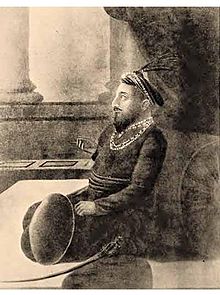Murshid Kuli Khan
| Murshid Quli Khan | |
|---|---|
|
Nawab Nazim of Bengal, Bihar and Odisha Zafar Khan (Bengali: জাফর খান Urdu:ظفر خان) Murshid Quli Nawab of Murshidabad |
|
 |
|
| Nawab of Bengal | |
| Reign | 1717– 30 June 1727 |
| Predecessor | Mughal Empire |
| Successor | Shuja-ud-Din Muhammad Khan |
| Spouse(s) | Nasiri Banu Begum |
|
Full name
Murshid Quli Khan
|
|
| Born |
c. 1660 Deccan Plateau |
| Died | 30 June 1727 Murshidabad (present day in West Bengal, India) |
| Buried | Katra Masjid, Murshidabad, India |
| Religion | Shia Islam |
Murshid Quli Khan, also known as Mohammad Hadi, was the first Nawab of Bengal, serving from 1717 to 1727.
Born as a Hindu Brahmin in the Deccan Plateau in c. 1670, Quli Khan was bought by Mughal noble Haji Shafi. After his death, he worked under the Divan of Vidarbha, during which time he piqued the attention of the then-emperor Aurangzeb, who sent him to Bengal as the Divan c. 1700. However, he entered into a bloody conflict with the province's subahdar, Azim-us-Shan. After Aurangzeb's death, he was transferred to the Deccan Plateau by Azim-us-Shan's father and the then Mughal emperor Bahadur Shah I in 1707; however, he was brought back as deputy subahdar in 1710. In 1717, he was appointed as the Nawab Nazim of Murshidabad by Farrukhsiyar. During his reign, he changed the jagirdari system with the mal jasmani which would later transform into zamindari system. He also continued sending revenues from the state to the Mughal empire. He built the Katra Masjid at Murshidabad where he was buried under the steps of stairs when he died on 30 June 1727. He was succeeded by his grandson Sarfaraz Khan.
According to Sir Jadunath Sarkar, he was originally a Hindu Brahmin born in Deccan in c. 1670. The book Ma'asir al-umara echoes this statement. At approximetely ten years od, he was bought by a Persian man named Haji Shafi who circumcised him and raised him with the name Mohammad Hadi. In c. 1690 Shafi left his position in the Mughal court and returned to Persia, where he was accompanied by Quli Khan. After Khan's death around five years later, he returned to India and worked under Abdullah Khurasani, the Diwan of Vidarbha in the Mughal empire. Due to his expertise in the matter, he was noticed by the then Mughal emperor Aurangzeb.
...
Wikipedia
